Christian Tamburr: Boundless Creativity
By Susan Frances
 From Cocoa Beach, Florida to the world stage, composer, bandleader, vibraphonist and multi-instrumentalist Christian Tamburr is a welcome sight to the jazz emporium. His open nature to receive new ideas and make new creations is boundless. From leading quartets, quintets, and septets, Tamburr’s various projects work to recharge his energy pack. His latest project, The Awakening: Sounds for Sculpture, showcases his talent for drawing inspiration from sculptures. The result is music that gives a voice to the artwork of sculptor Seward Johnson.
From Cocoa Beach, Florida to the world stage, composer, bandleader, vibraphonist and multi-instrumentalist Christian Tamburr is a welcome sight to the jazz emporium. His open nature to receive new ideas and make new creations is boundless. From leading quartets, quintets, and septets, Tamburr’s various projects work to recharge his energy pack. His latest project, The Awakening: Sounds for Sculpture, showcases his talent for drawing inspiration from sculptures. The result is music that gives a voice to the artwork of sculptor Seward Johnson.
He explains how he became acquainted with Johnson’s artwork. “I was lucky enough to be doing a performance at the Grounds For Sculpture in Hamilton, New Jersey in 2017,” he earmarks, “where I first experienced the full collection of Seward Johnson Sculptures.”
He chronicles, “I was walking through the amazing botanical gardens with close friend and musical cohort Clint Holmes. I do a lot of writing with Clint and I remember turning to him saying that each of the sculptures seemed to be a ‘scene frozen in time,’ as if they were from a play or production. I do a lot of writing for large productions globally and could just hear the music for each one of those amazing sculptures. I could hear the dialog or the underscore if someone were to ‘push play’ and the scene were to continue to unfold for each sculpture. I told Clint – ‘I hear the Sounds for these sculptures.’ He smiled and said, ‘follow what you hear.'”
The seeds for the project were planted and Tamburr began sowing them. He recalls, “The origin of the songs all stem from the sculptures themselves. After communicating with Seward Johnson and his Atelier, I selected around 14 of my favorite sculptures.”
From there, he points out, “I spent a few days in the park in 2018 taking pictures and just sitting absorbing the world that surrounded each of these amazing pieces. Some of them you can walk near and touch, and some of them are 60 ft in the air. I would hum ideas into my phone recording app and then listen back when I got back to my piano.”
“I write primarily on the piano,” he imparts, “and almost all of these songs were written through the process of listening to what I hummed while in the park and then expanded those melodic ideas into basic song forms.”
He describes, “I would sit looking at each of the sculptures and build a character base for them – give them a story – and I would write to that story. By imagining what transpired before and after the moment in which was caught/frozen by Seward in his sculpture, I could build a beginning, middle and end to the story behind each sculpture and thus develop a complete musical composition. Easier said then done,” he smiles.
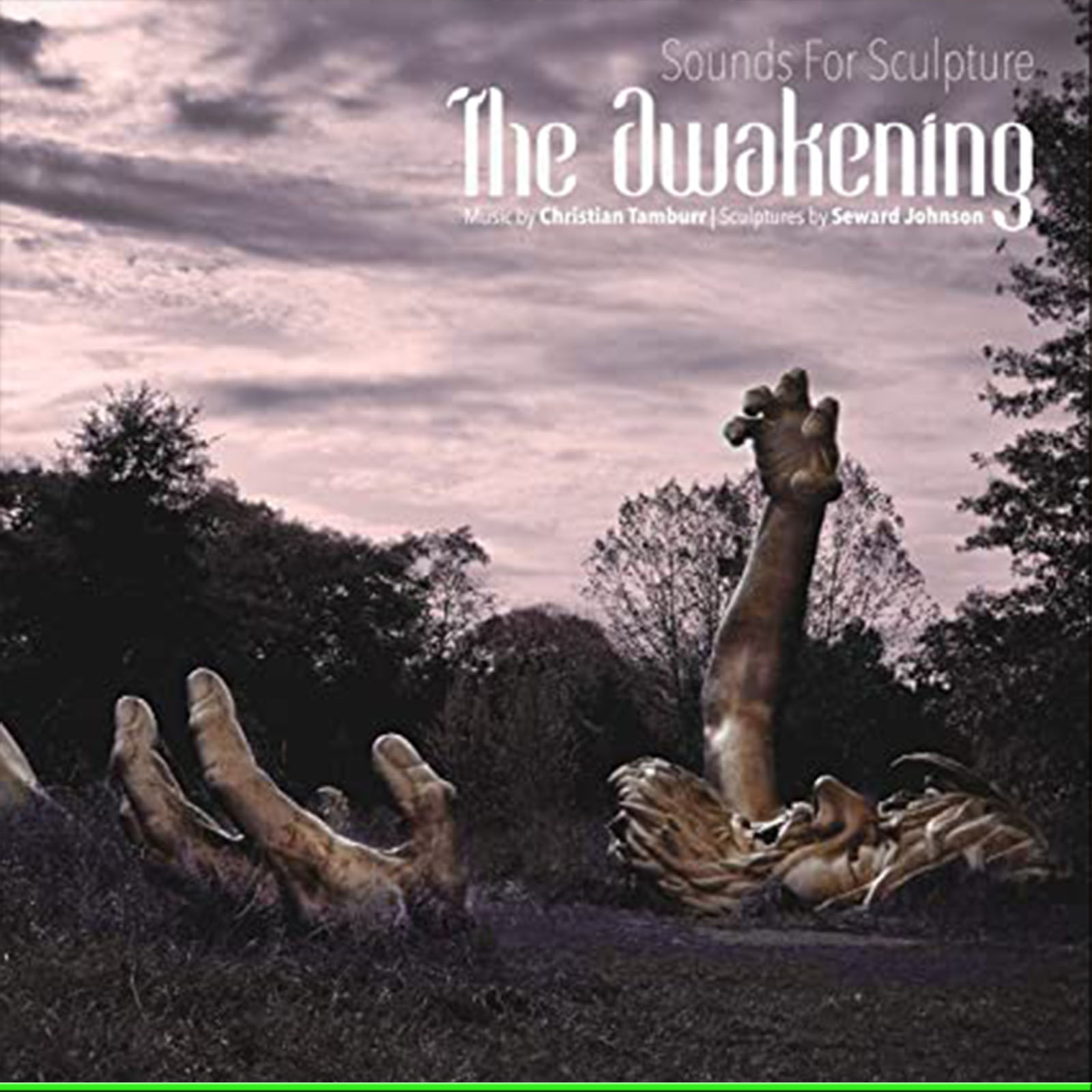 Tamburr amasses a septet for The Awakening: Sounds for Sculpture with himself on vibraphone, Linda Briceno on trumpet, Scott Giddens on piano, Billy Thornton on upright bass, John Davis on drums, Keith Ganz on guitar, and Mike Dobson on world/folly percussion. Also, joining him on the recording are special guests Dominick Farinacci on trumpet and his close friend and beacon, singer Clint Holmes.
Tamburr amasses a septet for The Awakening: Sounds for Sculpture with himself on vibraphone, Linda Briceno on trumpet, Scott Giddens on piano, Billy Thornton on upright bass, John Davis on drums, Keith Ganz on guitar, and Mike Dobson on world/folly percussion. Also, joining him on the recording are special guests Dominick Farinacci on trumpet and his close friend and beacon, singer Clint Holmes.
He reveals why he wanted Holmes to sing on the recording, “I knew a few of these songs for Sounds For Sculpture needed a deeper story through voice/lyrics and there was no hesitation as to who I would have work on those songs. He jumped at the opportunity and I was honored to have him a part of the project.”
Remembering how he met Holmes, he shares, “I first heard Clint Holmes when I was 21 years old performing in Las Vegas. He had a 8-year residency at Harrahs Casino with one of the top shows and band performing nightly there. It was known throughout Vegas and the west coast that performing with Clint was one of the best gigs to have. His influences range from jazz to soul to blues and has an incredible voice. I met him again years later and we got a chance to play a few songs together.”
“There was an immediate connection,” he asserts, “and in 2013, I invited him to join me on a jazz cruise that I produced for Regent Cruise Lines. He flew across the world and performed with me and my band for two weeks around the Mediterranean. That sealed the deal and we started collaborating. In 2015, I became his full-time pianist and musical director and we have been touring with each other going on 6 years now. In addition to being an incredible vocalist/entertainer, he is an outstanding poet/lyricist.,” he praises.
Tamburr’s reason for wanting Farinacci on the recording is equally personal and displays his affection for well built melodies. “There are 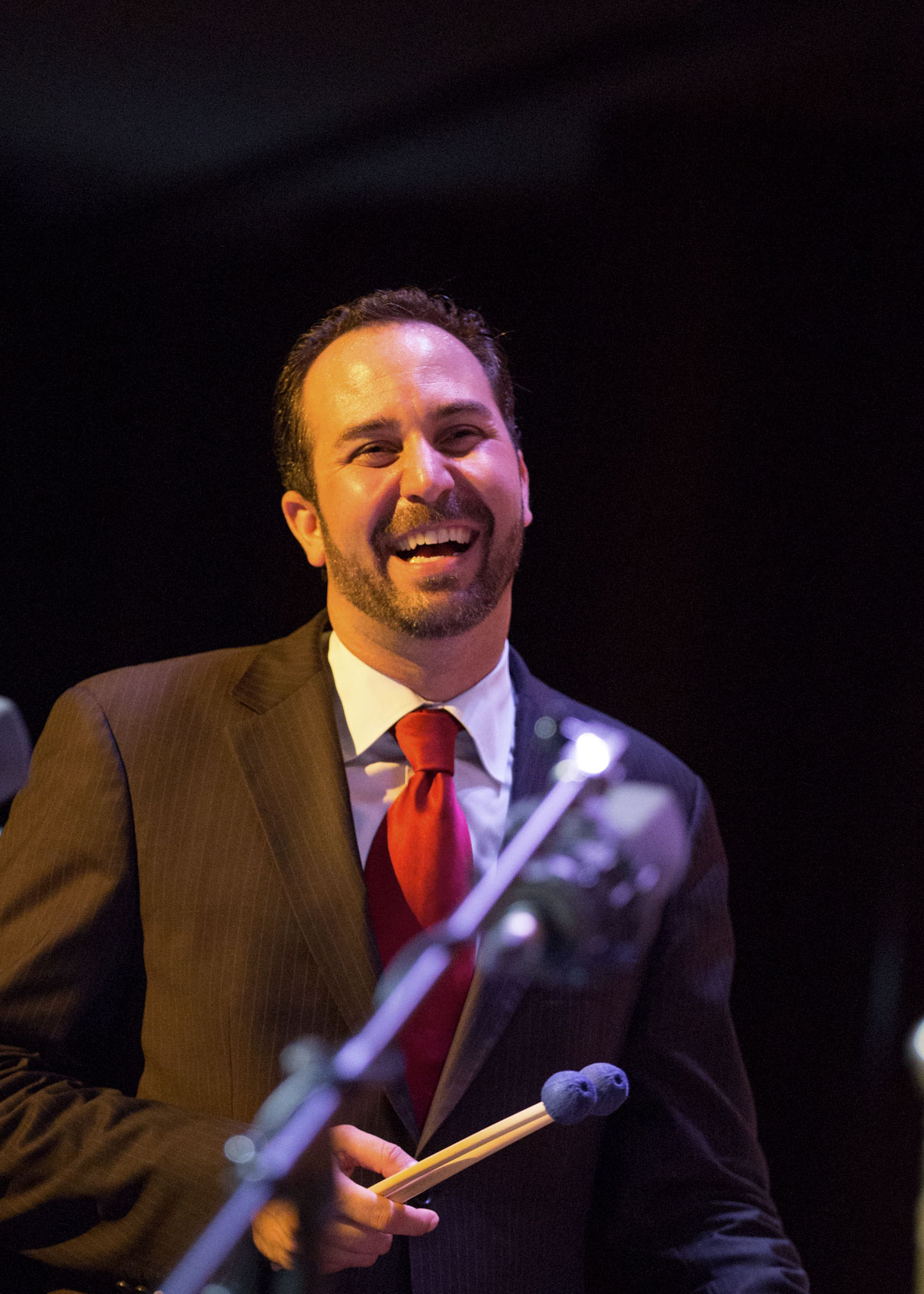 very few people I enjoy playing with more and laugh more with when we are together,” he exalts. “His approach to melody and tone matches so well with vibes, and I love what his playing brought to the Sounds For Sculpture project.”
very few people I enjoy playing with more and laugh more with when we are together,” he exalts. “His approach to melody and tone matches so well with vibes, and I love what his playing brought to the Sounds For Sculpture project.”
He remembers, “I first learned of Dominick Farinacci from our mutual mentor Ira Sullivan. Dominick is truly a one-long-lost brother from another mother,” he vouches. “We met in 2009 and have been touring and performing around the world ever since. From China to Doha to Aspen, we have always enjoyed the musical relationship and friendship.”
Farinacci plays on the track “Crack the Whip,” and makes a meaningful impression on the listener. Tamburr tells how he caught Farinacci while on one of his few lulls. “Dominick has a lot of things going on,” he examines, “seriously, he’s one of the busiest guys I know. When he arrived to the studio in Pittsboro, North Carolina, he was ready to play, but I could tell he needed some time with me to play the tunes together so we could figure out how to make it all work. After all, this music was brand new and we hadn’t toured or performed it yet. That’s a tough way to approach a recording because you want to ‘work it all out’ during live performances and then bring to the recording only the best of the best.”
“Since we didn’t have the luxury of ‘working it out,'” he continues, “we had to almost do that real time in the studio. He and I would play the melody together, split up the head/bridge and figure out where we would come back together. He has great suggestions and together we worked out how we were going to approach ‘Crack the Whip’ and the other tunes he plays on. The arrangement came alive with the melody split up on vibes and trumpet and the band latched onto that energy. From there, we just hit record and managed to get some really nice stuff,” he beams.
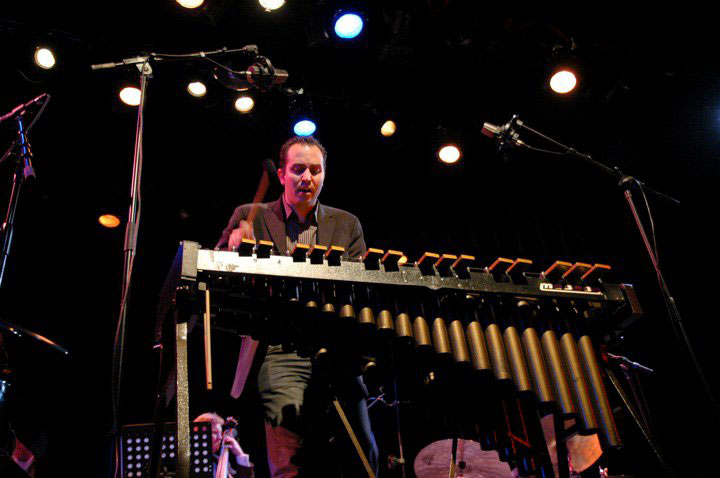 Also on the recording, the track “Hiding in the Light” sensually affects the listener. He recounts, “‘Hiding in the Light’ was one of the only songs I had actually written prior to this project. When I saw the sculpture, I knew immediately the melody, that I had written about a year prior, would be perfect for it. I knew the story I wanted to tell in this song and wrote that down. I shared that sometimes through email and sometimes singing in person with Clint. Clint took my story and my words and crafted a beautiful lyric. This was a true collaboration,” he treasures.
Also on the recording, the track “Hiding in the Light” sensually affects the listener. He recounts, “‘Hiding in the Light’ was one of the only songs I had actually written prior to this project. When I saw the sculpture, I knew immediately the melody, that I had written about a year prior, would be perfect for it. I knew the story I wanted to tell in this song and wrote that down. I shared that sometimes through email and sometimes singing in person with Clint. Clint took my story and my words and crafted a beautiful lyric. This was a true collaboration,” he treasures.
“When we finally had a working lyric,” he advances, “I remember playing it together in my home studio. We looked at each other and were both like ‘let’s sing it again.’ We must have done that 20 times – the excitement, sensitivity and passion for the story was all there in the lyric and coupled with the melody just worked.
“Working with Clint on any new song is always a ton of fun,” he expresses fondly. “We just step together through the whole process… hearing this all come together in the studio was very special and I’ll always remember that track!”
Another memorable moment for Tamburr was in August 2019, when he premiered The Awakening: Sounds For Sculpture with a live performance at New York City’s Jazz at Lincoln Center. He cherishes, “I have had the fortune of performing at Lincoln Center a number of times over the past 10 years and every time is special. I think back to what artist or project I have been with that brought me to that amazing venue and they are all important musical moments in my career. If I think back to those days in college when I was barely writing music to 2019, and now taking an entire original body of work and presenting it at one of the most iconic and important jazz venues in the world… well,” he reflects, “let’s just say that was life changing.”
He regards, “I was sharing the stage with some of my favorite musicians and friends, all there to help me share my music… our music. The friends at Jazz at Lincoln Center gave me such a beautiful opportunity to premier and share my original music and for that I’m forever grateful.”
Covid-19 put a halt to live performances through most of 2020 and into 2021, so plans for more events like the premier at Lincoln Center, Tamburr responds, “Ahh yes – the million dollar question. I hope so.
“It’s a very fluid situation with venues on hold around the world due to covid-19,” he remarks. “I think we all thought we would be out from under this by now, but my hope is to find as many creative ways to share this music as I can. We have done a handful of live performances and virtual shows. I share music through my instagram page – @christiantamburrproductions and through youtube. We do what we can to keep our music out into the world, but we all really look forward to being able to do it live soon!!”
In the interim, Tamburr’s creativity is continually being refueled. His quartet is ongoing as he proclaims, “I’m always doing stuff with my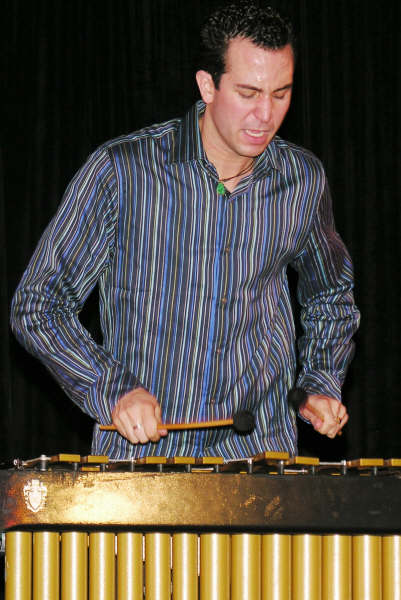 quartet – it’s kinda my go to ensemble. It’s where a lot of the creative ideas get their start. From there, I will flush things out for larger ensembles and projects.”
quartet – it’s kinda my go to ensemble. It’s where a lot of the creative ideas get their start. From there, I will flush things out for larger ensembles and projects.”
He admits, “I’m most at home in the quartet and recently it’s been the most efficient and cost effective way to keep even music from Sounds For Sculpture being performed. I will likely do a quartet project in the next year but I also have my sights set on a possible trio project where I’m playing piano. Who knows,” he speculates.
Tamburr’s schedule has also included leading master classes and workshops. These opportunities to discover aspiring musicians has kept him in touch with updated modern conveniences available to the new crop of artists. He considers, “Well musicians today have SO many more resources available to them. With youtube and streaming platforms, etc. there is an accessibility to so much more content then there was when I was younger. Their personal library of musical content is vast.”
He comments, “The only drawback to this way of absorbing the material is it’s done virtually.”
“For me,” he cites, “I had to learn a lot of it on the band stand – and I think that’s the biggest difference that I’ve discovered. Where some of these young students have a ton of music under their fingers, how they communicate it in real time to an audience or amongst an ensemble is a bit constrained.”
He ascertains, “The ability to take all that music and share it authentically requires passion, heart and emotion… That passion, heart and emotion comes from being on the stage and living and breathing the music… no amount of watching youtube can teach that,” he chortles. “All that being said, these young kids kick my ass on a regular basis and if anything it makes me practice more and more!!”
Experiencing new musicians in a classroom setting compels one to draw parallels between what education has been like for these students compared to what Tamburr’s own education had entailed. He provides, “Growing up, there was always music in my home. My father played acoustic guitar and from my earliest memories wanted to play like he did. I would sit on his lap strumming and eventually was able to play the guitar on my own at around 5 years old.”
“I inherited a baby grand piano when I was around 9,” he recollects, “and would essentially just use my ear to follow along with my dad on guitar while I was trying to play what he played on the piano.”
Moving on, he notes, “When I entered middle school, there was no option to take piano or guitar and had to enter ‘band.’ The only band that had those instruments was the jazz band and I was determined to make it in there so I could play the instruments I already knew. I selected percussion as my primary band instrument and quickly fell in love with drums and all the many classical percussion instruments. I started lessons in both classical and drumset still with my aim set on joining the jazz band.”
“The jazz band,” he assesses, “was made up of the top players and I was excited when I won a spot entering into 8th grade. There were better drummers in the band already, so I was reserved to playing mostly the slow, somewhat boring ballads on brushes. My band director saw me sitting around quite a bit and rolled out a vibraphone – he said: ‘This is a vibraphone – when you’re not playing drums, you are going to be playing this.’ I was totally enamored with the instrument, its sound and the early recordings of vibraphonists he shared with me – Lionel Hampton, Milt Jackson, Terry Gibbs Dream Band and I quickly dove head first into jazz.”
He made the leap from music student to live performer before reaching his teens as he prides, “I grew up near Cocoa Beach, Florida and there were actually quite a few small jazz clubs in that area. My parents would bring me to hear live jazz, and I would sit in on jam sessions, and on any band stand where the musicians would let a 12 year old roll a marimba on stage. I didn’t own my own vibraphone until I was 15.”
“I loved the community and culture of the musicians who performed jazz,” he professes. “It was a group of all kinds of different people with diverse backgrounds all playing together. Jazz was a true melting pot of inspiration and expanded my appreciation for music from all over the world.”
One musician who touched him deeply remains a spectre in his life as he vows, “One of the earliest inspirations was multi-instrumentalist – Ira Sullivan. He came up to some of the small jazz clubs in my area to perform and seeing him perform sort of sealed the deal for me. I remember thinking how some day I would love to play with someone like him. I was lucky enough to gain him as a mentor and we would go on to a friendship of over 25 years with him recording and touring with me throughout my professional career. He passed in September of 2020 and although he is gone, his music will continue to inspire me and all the other young musicians coming up around this country.”
He lists, “A few other early inspirations were Pat Metheny, Oscar Peterson, Gary Burton and Chick Corea.”
Becoming a composer of original work took slightly longer to hone but still kicked in at a much younger age than most artists can claim for themselves. “I was sort of forced to write my own music in college,” he confesses. “When I first started I really had a very limited understanding of the compositional rights and wrongs and wasn’t very good.”
He sizes up, “I was in some of the top ensembles in my college as a player but the students around me were much older and had a lot more schooling/training. I gave it my best but wasn’t really able to keep up.”
“I gave up writing until I was about 22 years old,” he ponders, “and wrote a song called Chief – It was the first song other people seemed to like and play. I wrote it while living out in Las Vegas performing nightly at the Bellagio Hotel and Casino with The Noel Friedline Quintet. I remember the first time I heard my own composition performed by a band and an audience. It was overwhelming and I was hooked.”
He assures, “I was inspired to continue writing by those friends and musicians around me who pushed me to continue to work on my compositional craft. The more they believed in the music I was writing, the more I started to believe in it.”
Developing self-confidence is an important driving force for Tamburr, who never tires of the profession he has chosen. He proposes, “I think the goal as a composer and musician is to continually grow… and what I can see over the past 20 years of performing and working in this industry is a pragmatic approach to how one goes about making a living as a musician.”
“When I was younger,” he estimates, “I wanted to just play jazz… I was then given the opportunity to write for production shows, work as a musical director, advise executives on leadership through attributes of music and I see that there is no one path on this journey… be open, you never know what, who, where or how you’ll be making music next. You get back what you put in and it’s a constant effort to push forward. It’s not easy, it never was… it probably never will be but I love it. I love it as much as I did when I was 13 years old playing in the little jazz clubs in Cocoa Beach.”
An ambitious youth from Cocoa Beach, Florida, Christian Tamburr has amassed a vast repertoire that he continues to see grow. Possessed with boundless energy to create, Tamburr looks to human passion for inspiration. Equally, his music awakens human passion in his listeners. His release The Awakening: Sounds for Sculpture is a personal reflection on the artwork of Seward Johnson but the music reaches audiences on other levels. The melodies incite them to make personal reflections about their own lives and the world around them. The parallels are endless, and Tamburr’s talent to tap into that endless stream is immeasurable.
About Susan Frances:
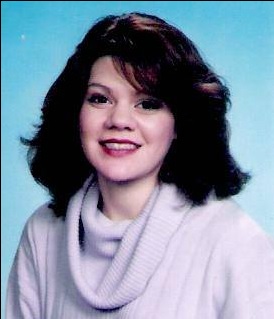 Born in Brooklyn, New York and raised in eastern Long Island, I always enjoyed writing and made several contributions to my high school literary magazine, The Lion’s Pen. Influenced by writers of epic novels including Colleen McCullough and James Clavell, I gravitated to creative writing. After graduating from New York University with a BA in Liberal Arts, I tried my hand at conventional jobs but always returned to creative writing. Since 1998, I have been a freelance writer and have over three thousand articles to various e-zines including: Jazz Times, Blogcritics, Yahoo Voices, Goodreads.com, Authors and Books (books.wiseto.com), TheReadingRoom.com, Amazon.com, Epinions.com, Fictiondb.com, LibraryThing.com, BTS emag, BarnesandNoble.com, RomanticHistoricalReviews.com, AReCafe.com, Hybrid Magazine, and BookDepository.com. In 2013 and 2014, I was a judge in the Orange Rose Writing Competition sponsored by the Orange County chapter of the Romance Writers of America located in Brea, California.
Born in Brooklyn, New York and raised in eastern Long Island, I always enjoyed writing and made several contributions to my high school literary magazine, The Lion’s Pen. Influenced by writers of epic novels including Colleen McCullough and James Clavell, I gravitated to creative writing. After graduating from New York University with a BA in Liberal Arts, I tried my hand at conventional jobs but always returned to creative writing. Since 1998, I have been a freelance writer and have over three thousand articles to various e-zines including: Jazz Times, Blogcritics, Yahoo Voices, Goodreads.com, Authors and Books (books.wiseto.com), TheReadingRoom.com, Amazon.com, Epinions.com, Fictiondb.com, LibraryThing.com, BTS emag, BarnesandNoble.com, RomanticHistoricalReviews.com, AReCafe.com, Hybrid Magazine, and BookDepository.com. In 2013 and 2014, I was a judge in the Orange Rose Writing Competition sponsored by the Orange County chapter of the Romance Writers of America located in Brea, California.





No Comments